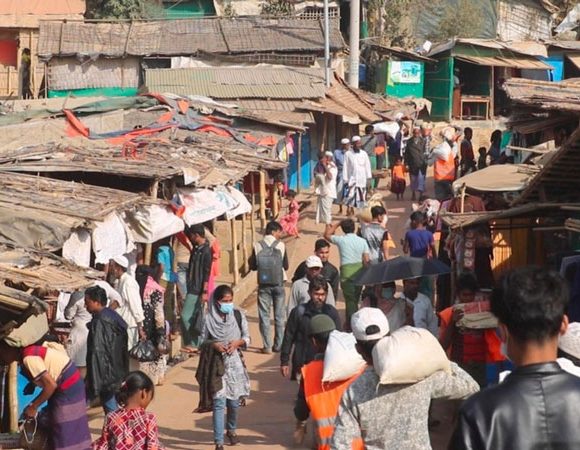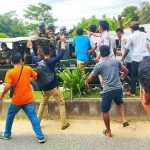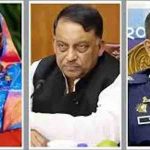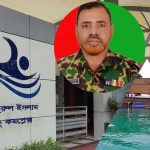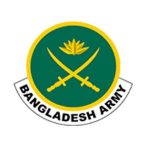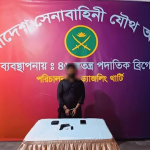Behind the story of the alleged rape in Khagrachari
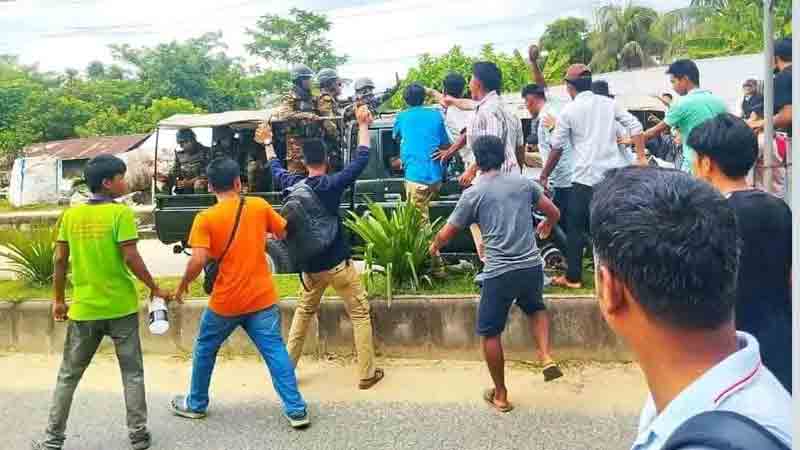
CHT Mirror Report
Khagrachari, the northern district of the Chittagong Hill Tracts, has seen days of unrest marked by strikes, blockades, protest marches, arson attacks, and violent riots over the alleged rape of an eighth-grade Marma girl.
Under the banner of a movement demanding justice, the five-day violence swept through the Sadar and Guimara upazilas.
According to reports by the district administration, led by the executive officers of Sadar and Guimara upazilas, three tribal civilians were killed. Seven others – six Bengalis and one tribal – were injured in Sadar, while 13 tribal residents were hurt in Guimara.
The attacks caused extensive damage to property. In Sadar, 28 individuals or families – 27 Bengali and one tribal – suffered losses, while in Guimara the number rose to 97, including 19 Bengali and 78 tribal households.
In Khagrachari Sadar, one motorcycle and two “tomtoms” (three-wheelers) owned by Bengalis were set ablaze. In Guimara, 43 vehicles – including a truck, a Mahindra jeep, and 41 motorcycles – were torched. Of these, seven belonged to Bengalis, 26 to tribal residents, and 10 owners could not be identified.
The district administration estimated financial losses at Tk 7.48 million in Sadar and Tk 77.76 million in Guimara. Beyond the numbers, the wave of strikes, blockades, and arson left behind deep fear and mistrust between communities – consequences that cannot be quantified.
On the other hand, alleging that a Marma teenage girl had been gang-raped by Bengalis and demanding justice and punishment, a protest procession and a human chain were held around 10:30 am on September 24 at Shapla Chattar in the district town. The event was organised under the leadership of Ukyanu Marma, General Secretary of the Khagrachari District Branch of the Awami League-backed Marma Students’ Council.
Later that day, from 2:30 pm to 3:45 pm, another protest march took place in the Swarnivar Bazar area of the Sadar upazila. This demonstration was jointly organised by the Hill Women’s Federation and the Hill Women’s Association, both supported by the UPDF (Main) faction.
Meanwhile, on the morning of September 24, a Facebook page titled “Jumma Chhatra-Janata” was launched. Through this page, a half-day blockade in Khagrachari was declared for September 25, followed by a grand rally on September 26, under the leadership of Ukyanu Marma. To prevent any disorder or unrest during the September 26 programme, the army requested Ukyanu Marma to come to the Sadar Zone headquarters for a discussion. She did not respond to the request. Later, at around 9 pm on September 25, security forces brought her in from Madhupur Bazar for necessary discussions and released her about half an hour later, around 9:30 pm.
The following day, September 26, from 12 noon to 3 pm, the scheduled rally was held at Chengi Square in Khagrachari Sadar. Protesters chanted slogans such as “Remove the army from the hills” and “Send the Bengalis back to the plains,” which further intensified tensions. In her speech, Ukyanu Marma claimed she had been forcibly taken away and she demanded the withdrawal of the army from the hills.
At approximately 12:30 pm, while the rally was in progress, an army pickup truck passed by the venue. Protesters attacked the vehicle, pelting it with bricks and stones. Four soldiers were injured in the attack, and the vehicle was damaged. The demonstrators also vandalised an autorickshaw. Before concluding, the rally organisers announced a dawn-to-dusk blockade in Khagrachari for September 27.
What sparked the incident
In the Singinalla area of Khagrachari Sadar, an eighth-grade Marma schoolgirl went missing on the night of September 23. She had gone to her private tutor’s home for lessons and was expected to return by 9:00 pm, but did not come back.
Her father visited the teacher’s house and was told that the girl had left for home at the usual time, around 9:00 pm. Failing to find her, the father and other relatives began searching through the area. Around 11:00 pm, they found her unconscious in a paddy field about 150 feet from the teacher’s house, lying in knee-deep muddy water.
Locals brought her to a nearby shop, sprinkled water on her face, and she regained consciousness. Based on her brief account before fainting again and observations at the scene, her family and locals suspected that she had been gang-raped.
That very night, she was admitted to Khagrachhari Sadar Hospital. Early the next morning, her father filed a General Diary (GD) at the Sadar Police Station, naming three unidentified suspects.
Later that morning, around 10:00 am on September 24, police, with assistance from the army, arrested 19-year-old Shoyon Sheel, the younger son of local resident Bappi Sheel, as a suspect. He was produced before court, which granted six days of police remand.
How the hill-Bengali clash began
On 27 September, a dawn-to-dusk road blockade was enforced under the banner of Jumma Chhatra-Janata, a platform backed by the United People’s Democratic Front (Main), to protest the alleged rape incident.
Around 12:45 pm, during the blockade, a Bengali motorcyclist travelling from Swanirbhar Bazar to Shapla Chattar was stopped near the Khagrachhari Upazila Parishad road, and his motorcycle was seized by UPDF picketers. The group also hurled a crude bomb at three or four Bengali youths standing near a nearby shop. As news spread, angry Bengalis gathered, triggering a chase and counter-chase between protesters and picketers.
Army and police personnel rushed to the scene and tried to disperse the crowd, but the hill protesters responded with brickbats and slingshots. As the situation escalated, the army fired about 30 blank rounds and police launched 40 sound grenades. Despite this, UPDF supporters vandalised the windows of the Upazila Parishad mosque, an ambulance, a motorcycle, about 20 Bengali shops at Swanirbhar Bazar, and an autorickshaw. In retaliation, Bengali groups vandalised several hillmen’s shops and threw stones at a house in Mahajan Para.
As violence intensified, the district administration imposed Section 144 from 2 pm across Khagrachhari Municipality and the Sadar and Guimara upazilas.
Defying the order, Jumma Chhatra-Janata announced an indefinite blockade on Facebook from 28 September but withdrew it later that night. Under UPDF pressure, however, the group reinstated the blockade around 11:20 pm. Ten minutes later, three tribal youths armed with knives, sticks, and Chinese machetes were seen near the Youngda Buddha Bihar allegedly preparing for sabotage. Locals, with army help, captured them and handed them over to police. The next morning, 28 September, they were sent to jail by the Chief Judicial Magistrate’s Court.
That morning, a crisis meeting was held at the Deputy Commissioner’s office, attended by Supradeep Chakma, Adviser to the Ministry of Chittagong Hill Tracts Affairs, along with local leaders, security and intelligence officials, journalists, and political representatives.
Meanwhile, at 11 am, UPDF-backed Hill Student Council members blocked the Khagrachhari-Chattogram road at Ramsu Bazar by burning logs and tyres. When security forces arrived and ordered them to clear the road, protesters threw stones and vandalised Bengali shops and houses. The Bengalis retaliated, sparking fierce clashes. The army resorted to baton charges and fired about 20 blank rounds to restore order. Around 50 shops, nine houses, and one turmeric mill were vandalised or burned.
As Bengali groups regrouped, armed UPDF members opened fire from nearby hills. Ten army personnel, four policemen, and thirteen tribal people were injured, while three tribal men were killed. Officials later recovered the bodies and took the injured to Khagrachhari Sadar Hospital. Ten people received treatment there, with one referred to Chattogram Medical College Hospital.
The deceased were kept in the hospital morgue and handed over to their families after postmortem on the night of 29 September. The cremations took place in their respective villages with police assistance, while the wounded were later transferred to Chattogram for further treatment under the district administration’s supervision.
Peace initiative
In an effort to end the blockade and violence in Khagrachhari, members of the local administration and intelligence agencies reached out to Angya Marma, the Khagrachhari district organiser and spokesperson of the United People’s Democratic Front (Main), for dialogue.
Although Angya Marma declined to attend in person, he agreed to send representatives on his behalf.
Accordingly, on 29 September, a meeting was held from 12:30 pm to 2:30 pm at the District Circuit House, chaired by the Adviser to the Ministry of Chittagong Hill Tracts Affairs. Six representatives of Jumma Chhatra-Janata – Bagis Chakma, Chadak Chakma, Kripayon Tripura, Pintu Talukdar, Toshita Chakma, and Manik Chakma – joined the discussion.
Among others present were the Detachment Commander of the DGFI, the Deputy Commissioner, the Superintendent of Police, and the Chairperson of the District Council, Shefalika Tripura.
CHT Mirror investigation
Following the peace meeting on 29 September, tension in Khagrachhari began to ease. Meanwhile, the alleged rape of a Marma schoolgirl in Singinala on the night of 23 September – which had triggered days of unrest – took a new turn after the release of the medical report on 30 September.
The report, prepared by a three-member board headed by gynaecologist Dr Joya Chakma and including Dr Mosharraf Hossain and Dr Nahida Akhter of Khagrachhari Modern Sadar Hospital, found no evidence of rape. Dated 28 September, it marked all ten clinical indicators for sexual assault as “normal.”
Police advised the victim’s father – the complainant – to request further examination if he doubted the findings, but he declined. Khagrachhari District Council Chairperson Shefalika Tripura said she had personally urged the girl’s father to take her to Chattogram Medical College for an advanced test but he refused.
Seeking clarity, CHT Mirror carried out an independent inquiry. It found that in Singinala, the area where the alleged rape occurred, there are no Bengali households and that Bengalis usually avoid the locality after dark. The girl’s home lies only 300 feet from her tutor’s house, with two Marma-owned shops about 30 feet away. She attended tuition there from 6 pm to 9 pm while her father typically waited nearby.
When she failed to return by 9:30 pm, her father went to the tutor’s house and was told she had left at 9 pm. About two hours later, she was found unconscious in a muddy paddy field roughly 150 feet away. Locals took her to a nearby tea stall and sprinkled water on her face until she regained consciousness, telling them someone had struck her from behind with a brick.
At 10:43 pm, Abai Marma, general secretary of the local Mengmaong Club, phoned a Bengali resident, Md Khorshed, asking whether any Bengali men had passed through. Khorshed refused and cautioned him against blaming anyone before verification. Later, Abai called back, saying the girl was “possessed by a spirit” and was being treated by a local healer. By 11:40 pm, he said she was ill and was being taken to hospital.
Around 1:40 am, 50–60 tribal men and women gathered outside Khorshed’s home, claiming the girl had identified Nayon Shil, son of local resident Bappi Shil, as the rapist. When confronted, Bappi produced a video call proving that Nayon was studying at Kaptai Polytechnic Institute. The crowd then accused his younger son, Shoyon, instead. Khorshed protested, urging them to let the law take its course.
At the same time, Abai’s brother-in-law Ukhanu Marma, general secretary of the pro-Awami League Bangladesh Marma Students’ Council (BMSC), posted on Facebook that three Bengali men had raped a Marma girl. Other activists, including Moni Marma and Iman Chakma, shared posts with Nayon’s photo, falsely accusing him. The allegations spread quickly online.
At 12:40 am, Ukhanu and others took the girl and her father to Khagrachhari Sadar Hospital and demanded an immediate rape test. When doctors explained that formalities were required, they left her admitted. Around 12:30 am and again at 2:00 am, Ukhanu called the officer-in-charge of Khagrachhari Model Police Station, pressing him to register a rape case.
At 4:45 am, under pressure, the girl’s father filed a General Diary accusing three unidentified men, which was converted into a formal case at 12:30 pm on 24 September. That morning, a medical board collected samples from the girl for examination. At the same time, under Ukhanu’s direction, a Facebook page titled Jumma Chhatra-Janata was launched to announce protest programmes. Around 10 am, with army assistance, police detained Shoyon Shil as a suspect; the court later granted six days’ remand.
As the police investigation began, protests and human chains erupted across Khagrachhari on 24 September, spiralling into five days of riots and arson in Khagrachhari and Guimara. When the medical report later confirmed no signs of rape, questions arose over the legitimacy of those protests.
Locals also questioned whether a rape could occur in a flooded paddy field knee-deep in water, as claimed by the family.
Bappi Shil, father of the accused, told CHT Mirror: “First they accused my elder son. When I proved he was away, they blamed my younger son instead. That night he was shopping for Durga Puja in town – police have the CCTV footage. They’ve destroyed my salon in Swanirbhar Bazar. My family has been framed.”
When contacted, Abai Marma confirmed calling Khorshed multiple times but said he only repeated what he had heard from the girl’s family. Asked why the accusation shifted from one brother to another, he replied, “The girl identified him; we didn’t.”
The girl’s father told BBC Bangla they would not contest the medical report in court, citing financial hardship. Chairman of Khagrachri Hill District Council’s Shefalika Tripura reiterated that she had offered help for a higher-level test, but the family declined.
Investigating Officer SI Md Alauddin told CHT Mirror on 22 October: “The victim identified Shoyon Shil as the rapist, so he was detained. The other suspects remain unidentified, and efforts to find them continue.”
Asked about CCTV footage showing Shoyon shopping during the alleged time of the assault, the officer said: “The rape was reportedly around 9 pm, and CCTV confirms Shoyon was seen in several shops between 9 and 9:45 pm. We are verifying all details. The truth will emerge after investigation.”
UPDF connection
At a negotiation meeting held at the Khagrachhari District Circuit House, chaired by Supradip Chakma, Adviser to the Ministry of Chittagong Hill Tracts Affairs, the representatives who joined on behalf of the demonstrators were actually representatives of Angya Marma.
Officials said the administration had specifically reached out to Angya Marma for talks. He, however, declined to attend in person and nominated representatives to participate on his behalf.
The meeting began at 12:30 pm on 29 September and was attended by Bagish Chakma, Chadok Chakma, Kripayon Tripura, Pintu Talukdar, Toshita Chakma, and Manik Chakma under the banner of Jumma Chhatra-Janata.
After the meeting, Adviser Supradip Chakma told reporters: “I asked the six who attended on behalf of Jumma Chhatra-Janata: who among you are from the UPDF? They admitted that all of them are members of the UPDF.”
Meanwhile, UPDF organiser Michael Chakma, speaking on a private television talk show, commented on the slogans raised during the so-called anti-rape movement in Khagrachhari – including “Remove the army from the hills” and “Send back the Bengalis” – saying, “Rape was merely a pretext.”
Neighbour connection
Local intelligence sources have reported, based on intercepted phone communications, that several senior figures of a regional armed group operating across the border made calls to local contacts in Khagrachhari. During these conversations, they allegedly encouraged provocative actions, including attacks on army personnel, and conveyed assurances of support.
According to the intelligence findings, the callers promised the recipients “all kinds of patronage,” including offering refuge across the border if legal action was taken against them, and medical treatment in case of injury.
Officials further said intelligence agencies have obtained evidence of direct communication between Jumma Chhatra-Janata and fugitive leaders of the Awami League. These absconding political figures reportedly contacted hill leaders by phone, assuring them of both financial and logistical support.
Security officials have therefore described the unrest in Khagrachhari not simply as fallout from an alleged rape case, but as part of a broader, multi-layered conspiracy involving cross-border and political elements.



